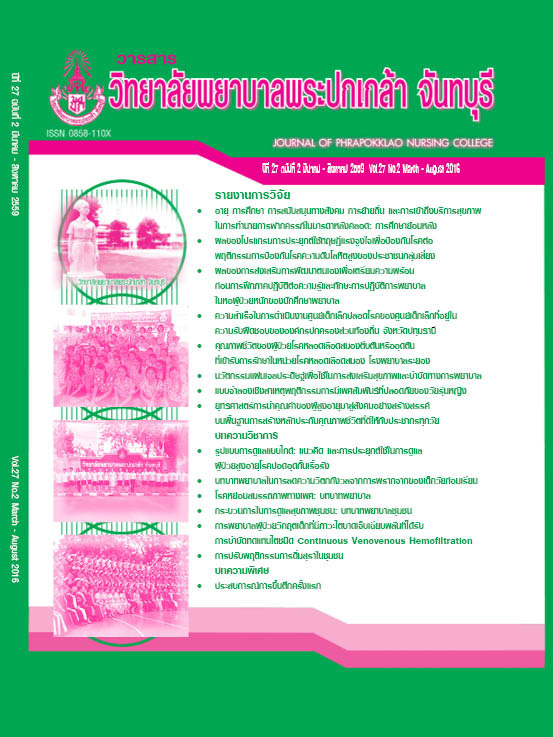The Role of Nurses in Reducing Separation Anxiety in Pre-school Children
Keywords:
-Abstract
-
References
กวี สุวรรณกิจ. (2541). โรควิตกกังวลในเด็กและวัยรุ่น. กรุงเทพฯ: เมดิคัล มีเดีย.
ชมรมจิตแพทย์เด็กและวัยรุ่นแห่งประเทศไทย. (2556). พื้นฐานอารมณ์: ความแตกต่างระหว่างเด็กแต่ละคน. สืบค้น วันที่ 12 ธันวาคม 2556, จาก http://www.rcpsycht.org/cap/book01_12.php
ณัชนันท์ ชีวานนท์, และมณีรัตน์ ภาคธูป. (2559). ปัจจัยที่มีความสัมพันธ์กับความวิตกกังวลจากการพรากจากของเด็กวัยก่อนเรียน ตามการรับรู้ของมารดา ในสถานรับเลี้ยงเด็ก จังหวัดชลบุรี. วารสารพยาบาลกระทรวงสาธารณสุข, 26(1), 161-175.
ศรีสมบูรณ์ มุสิกสุคนธ์, ฟองคำ ติลกสกุลชัย, วิไล เลิศธรรมเทวี, อัจฉรา เปรื่องเวทย์, พรรณรัตน์ แสงเพิ่ม, และสุดาภรณ์ พยัคฆเรือง. (บ.ก.). (2555). ตำราการพยาบาลเด็ก เล่ม 1 (พิมพ์ครั้งที่ 3). กรุงเทพฯ: พรี-วัน.
สมภพ เรืองตระกูล. (2556). ตำราจิตเวชศาสตร์ (พิมพ์ครั้งที่ 10). กรุงเทพฯ: เรือนแก้วการพิมพ์.
แสงทอง เลิศประเสริฐพงศ์. (2544). ความวิตกกังวลเกี่ยวกับบุตรที่ถูกแยกจากมารดา การรับรู้พฤติกรรมทารกแรกเกิด กับสัมพันธภาพระหว่างมารดากับทารกในมารดาที่ได้รับการผ่าตัดเอาทารกออกทางหน้าท้อง (วิทยานิพนธ์ปริญญามหาบัณฑิต). กรุงเทพฯ: มหาวิทยาลัยมหิดล.
อาภาพรรณ ทีฆวิวรรธน์. (2547). ผลของโปรแกรมการเตรียมความพร้อมต่อความวิตกกังวลจากการพรากจาก ของเด็กวัยเดินที่แรกเข้ารับบริการในศูนย์สาธิตการพัฒนาเด็ก คณะพยาบาลสาสตร์ มหาวิทยาลัยขอนแก่น (วิทยานิพนธ์ปริญญามหาบัณฑิต). มหาวิทยาลัยขอนแก่น.
Baby Centre Medical Advisory Board. (2008). Your anxious child (ages 3 to 4). Retrieved October 28, 2013, from http://www.babycentre.co.uk/a1022260/your-anxious-child-ages-3-to-4m
Balaban, N. (2013). Easing the separation process for infants, toddlers, and families. Retrieved March 20, 2014, from http://www.naeyc.org/files/yc/file/200611/BTJBalaban.pdf
Baumrind, D. (1989). Child development today and tomorrow. San Francisco, C.A.: Jossey Bass.
Bowlby, J. (1973). Attachment and Loss: Volume II separation: anxiety and anger. New York: The Tavitock Institute of Human Relation.
Cassidy, J., & Shaver, P. R. (1999). Handbook of attachment: Theory, research, and clinical applications. New York: The Guilford Press.
Commodari, E. (2013). Preschool teacher attachment, school readiness and risk of learning difficulties. Early Childhood Research Quarterly, 28(1), 123-133.
Ellen, J. M., Gina, H., Healther, L., Jaelline, J., & Jeanne, S. (2008). Separation anxiety and separation anxiety disorder. Retrieved October 28, 2013, from http://helpguide.org/mentalsepara-tion_anxiety_causes_prevention_treatment.htm
Field, T., & Reite, M. (1984). Children’s responses to separation from mother during the birth of another child. Child Development, 55(4), 1308-1316.
Garmezy, N. (1983). Stressors of childhood. In Garmezy, N., & Rutter, M. (Eds.). Stress, coping, and development in children. pp. 43-84. New York: McGraw-Hill.
Hammen, C., Gordon, D., Burge, D., Adrian, C., Jaenicke, C., & Hiroto, D. (1987). Maternal affective disorders, illness, and stress: Risk for children’s psychopathology. The American Journal of Psychiatry, 144(6), 736-741.
Hockenberry, M. J., & Wilson, D. (2015). Wong’s nursing care of infants and children (10th ed.). St.Louis: Mosby.
Kaminski, J. (1998). Cultural factors and separation anxiety in preschoolers. Retrieved October 20, 2014, from http://hygeia-design.com/sep_anxiety.pdf
Learnard, K. (2002). Infant & toddlers separation anxiety: Preparing you & your child for separation. Retrieved October 20, 2014, from http:www.allaboutbaby.com/infants/separate.htm
Littlejohn, M. (2013). How the Bowlby attachment theory applies to early childhood and adult therapy. Retrieved March 20, 2014, from http://www.spiritualbirth.net/how-the-bowlby-attachment-theory-applies-to-early-childhood-and-adult-therapy
McLeod, S. (2013). Attachment theory. Retrieved March 11, 2013, from http://www.simplypsychology.org/attachment.html
Motamedi, B. (2013). Children’s health anxious child age 1 to 3. Retrieved March 11, 2013, from http://www.Ahealthyvantage.com/topic/anxious1to3
Murphy, M. A. (1993). Anxiety and daycare: Effects on mother, and children’s separation behavior. Paper presented at the American Psychiatric Association; 20-24 August 1993. Toronto Ontario, Canada.
Potts, N. C., & Mandleco, B. L. (2007). Pediatric nursing caring for children and their families (2nd ed.). New York: Thomson Delmar Learning.
Schore, A. N. (2001). Effects of a secure attachment relationship on right brain development, affect regulation, and infant mental health. Infant Mental Health Journal, 22(1-2), 7-66.
Spencer, A. R. (2006). Childhood and adolescence: Voyages in development. Canada: Thomson Learning.
Teung, A. G. (1982). Growth and development: A self-mastery approach. Connecticut: Appleton-Century Crofts.
Thomas, A., & Chess, S. (1977). Temperament and development. New York: Brunner/Mazel.
Videbeck, S. L. (2008). Psychiatric-mental health nursing (4th ed.). Philadelphia: Williams & Wilkins.
Watkins, C. E. (2001). Separation anxiety in young children. Retrieved October 28, 2015, from http://www.baltimorepsych.com/separation_anxiety.htm
Weiss, L. H., & Schwarz, J. C. (1996). The relationship between parenting types and older adolescents’ personality, academic achievement, adjustment, and substance use. Child Development, 67(5), 2101-2114.
Wolfradt, U., Hempel, S., & Miles, J. N. V. (2003). Perceived parenting styles, depersonalisation, anxiety and coping behaviour in adolescents. Personality and Individual Differences, 34(3), 521-532.
Young, A. R., & Szpunar, M. (2012). Parenting and fear and anxiety in young children integrating. Science and Practice, 2(1), 10-14.
Downloads
Published
How to Cite
Issue
Section
License
Copyright (c) 2016 Journal of Phrapokklao Nursing College

This work is licensed under a Creative Commons Attribution-NonCommercial-NoDerivatives 4.0 International License.
เนื้อความ ข้อมูล และรายการอ้างอิงที่ผู้เขียนใช้ในการเขียนบทความเพื่อลงตีพิมพ์ในวารสารวิทยาลัยพยาบาลพระปกเกล้า จันทบุรี ถือเป็นความคิดเห็นและความรับผิดชอบของผู้เขียน คณะผู้จัดทำวารสารไม่จำเป็นต้องเห็นพ้องด้วยหรือร่วมรับผิดชอบ
บทความที่ได้รับการลงตีพิมพ์ในวารสารวิทยาลัยพยาบาลพระปกเกล้า จันทบุรี ถือเป็นลิขสิทธิ์ของวารสารวิทยาลัยพยาบาลพระปกเกล้า จันทบุรี หากหน่วยงานหรือบุคคลใดต้องการนำส่วนหนึ่งหรือทั้งหมดของบทความไปเผยแพร่ต่อเพื่อวัตถุประสงค์ใด ๆ จะต้องได้รับอนุญาตจากบรรณาธิการวารสารก่อน



